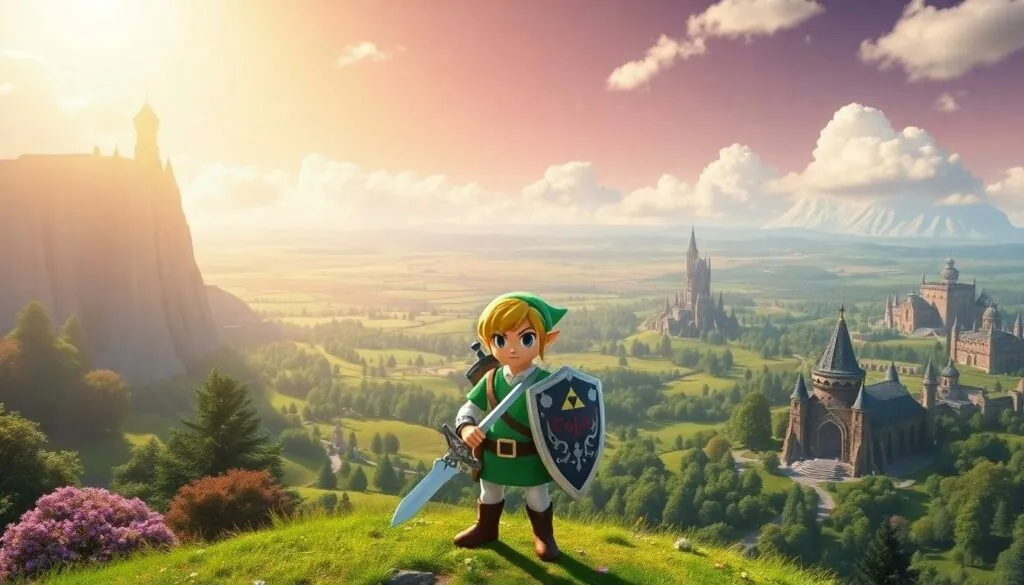In the realm of gaming, few franchises have captured hearts like The Legend of Zelda. When it made the leap to 3D, it didn’t just change the game; it revolutionized it. Imagine the thrill of exploring Hyrule in a whole new dimension, where Link’s adventures took on a life of their own. It was like watching your favorite cartoon jump off the screen and into your living room.
Table of Contents
ToggleOverview Of The First 3D Zelda Game
The first 3D Zelda game, The Legend of Zelda: Ocarina of Time, debuted in 1998 for the Nintendo 64. Players experienced a groundbreaking transformation in gameplay, shifting from 2D perspectives to a fully immersive 3D environment. This game introduced a dynamic combat system, alongside utilizing the Z-targeting mechanic, which allowed players to focus on enemies easily.
Adventurous exploration marked a significant aspect of its gameplay. Players navigated vast landscapes, solved puzzles, and engaged with numerous characters, all within the rich world of Hyrule. The introduction of a time-travel mechanic added depth to the narrative, creating a unique storyline that captivated audiences.
Critical acclaim followed its release, with numerous publications recognizing it as one of the greatest video games of all time. A perfect balance existed between the action, puzzles, and storytelling elements, which set a new standard for future video game development. The game achieved numerous awards and sold over 7.6 million copies worldwide.
Innovations extended beyond gameplay mechanics. Graphics and sound design advanced significantly in the transition to 3D. Iconic music composed by Koji Kondo enhanced the emotional connection, further immersing players in the adventure.
Ocarina of Time became a cornerstone of the Zelda series, influencing countless games in the action-adventure genre. The compelling blend of exploration, narrative, and innovative gameplay mechanics left a lasting impact on the gaming community, establishing a benchmark for future titles in the franchise.
Gameplay Mechanics
The gameplay mechanics of The Legend of Zelda: Ocarina of Time play a crucial role in the immersive experience. Players explore a rich, expansive world filled with diverse environments, creatures, and secrets.
Exploration and World Design
Hyrule’s design encourages exploration. Open fields, dense forests, and intricate dungeons invite players to discover hidden items and lore. Each region presents unique challenges and delights. Players encounter various characters and engaging side quests that deepen the experience. Landmarks dot the landscape, helping players navigate and remember significant locations. Environmental storytelling adds depth, revealing history and secrets through visual cues.
Combat Systems
Combat in Ocarina of Time introduces innovative mechanics. The Z-targeting system allows players to lock onto enemies, enhancing focus during battles. This feature simplifies combat, making battles more intuitive. Players can utilize different weapons and items, including swords, bows, and bombs, each serving a specific purpose. The game includes a variety of enemy types, each demanding different strategies and approaches. Timing and spatial awareness become essential, as players learn to dodge patterns and exploit weaknesses.
Visual and Audio Presentation
The visual and audio presentation of The Legend of Zelda: Ocarina of Time greatly contributed to its immersive experience.
Graphics and Art Style
Graphics transformed with the transition to 3D environments. Hyrule featured richly detailed landscapes, from vast fields to lush forests and intricate dungeons. Art style captured a vibrant, colorful aesthetic that brought the world to life, enhancing player engagement. Character designs stood out, with Link and Zelda showcasing distinctive looks that resonate with fans. Polygonal graphics, albeit limited by the Nintendo 64’s technology, brought a new depth that players had never experienced. Distinct animations added personality to every character and creature, immersing players further in their quests and challenges.
Soundtrack and Audio Effects
Soundtrack played a crucial role in setting Ocarina of Time’s tone. Koji Kondo’s compositions included memorable melodies that echoed throughout Hyrule, creating an emotional connection with players. Each area featured unique musical themes, enhancing the atmosphere and reflecting the environment’s mood. Audio effects complemented the gameplay, adding authenticity to combat with sword clashes and enemy sounds. Environmental soundscapes invited players to feel the world around them, from gentle rustling leaves to the haunting calls of distant creatures. Together, the soundtrack and audio effects enriched the adventure, leaving a lasting impact on players.
Impact on the Gaming Industry
The Legend of Zelda: Ocarina of Time significantly influenced the gaming industry by setting a new standard for 3D action-adventure games. Innovations in gameplay mechanics emerged, primarily through the introduction of the Z-targeting system, which allowed players to concentrate on specific enemies during combat. This feature not only streamlined battles but also enhanced spatial awareness, fundamentally changing how players interacted with their environments.
The compelling narrative structure and time-travel mechanic enriched the storyline, showcasing how storytelling could evolve in video games. Players engaged more deeply with the plot, establishing a benchmark for narrative depth in the genre. Many subsequent titles drew inspiration from Ocarina of Time, incorporating similar mechanics and storytelling techniques.
Remarkable artistic elements also contributed to Ocarina of Time’s legacy. The game’s graphical capabilities represented a leap forward for the Nintendo 64, showcasing richly detailed environments and character designs that captivated players. Iconic music composed by Koji Kondo provided emotional resonance, reinforcing the bond between players and the game world. Music became another aspect of gameplay that significantly increased immersion.
The success of Ocarina of Time paved the way for future 3D games, including entries in the Zelda series that followed. Many developers adopted its formula, blending exploration, puzzle-solving, and combat. A plethora of games across various genres emerged, reflecting elements first popularized by Ocarina of Time.
Award recognition and commercial success illustrated the impact on the industry, with over 7.6 million copies sold. Critics hailed the game as one of the greatest of all time, cementing its position in gaming history. Overall, Ocarina of Time reshaped expectations for video games, demonstrating the potential for innovation, storytelling, and player engagement in the gaming industry.
Legacy of The First 3D Zelda Game
The Legend of Zelda: Ocarina of Time established a profound legacy that extends beyond its initial release. Released in 1998, this title revolutionized the gaming landscape and set a benchmark for future 3D action-adventure games. Players often cite the Z-targeting mechanic as a game-changer, as it enhanced combat dynamics and improved player navigation.
Ocarina of Time also showcased an innovative blend of storytelling and gameplay. Time travel served as a pivotal narrative device, allowing players to experience Hyrule’s history and influence its future. Critics praised the game for its compelling plot, which deepened emotional engagement and immersive experiences.
In terms of commercial success, Ocarina of Time sold over 7.6 million copies globally. Many awards solidified its status as one of the greatest video games ever created. This achievement not only reflected player preference but also influenced game development trends, pushing studios to adopt similar mechanics in other titles.
Visual presentation marked another area of impact. Graphics transformed in this transition to 3D, featuring detailed environments and a vibrant art style. Players recognized the authenticity brought by atmospheric sound design, which combined with memorable musical themes created by Koji Kondo.
The influence of Ocarina of Time remains significant in the gaming industry. Innovations in gameplay mechanics and artistic direction inspired numerous subsequent games. Developers now prioritize narrative depth and immersive environments, a shift largely attributed to the legacy of this iconic title. Players still regard Ocarina of Time as a milestone, encapsulating the essence of adventure in gaming and shaping the future of the action-adventure genre.
Conclusion
The Legend of Zelda: Ocarina of Time stands as a monumental achievement in gaming history. Its innovative mechanics and immersive storytelling set a precedent that continues to influence the action-adventure genre. Players still cherish the vibrant world of Hyrule and the unforgettable experiences it offers.
Ocarina of Time’s legacy is evident in the countless titles that followed, each drawing inspiration from its groundbreaking design and narrative depth. As players embark on their adventures, they carry with them the spirit of exploration and discovery that this iconic game instilled. The impact of Ocarina of Time is undeniable, securing its place as a timeless classic in the hearts of gamers everywhere.




